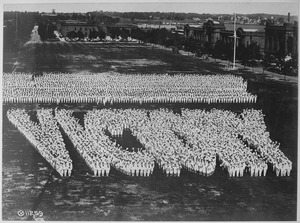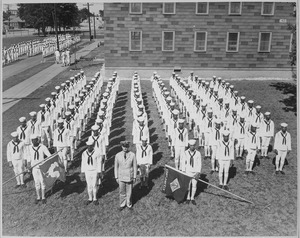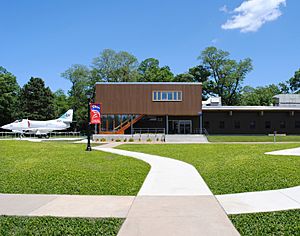Naval Station Great Lakes facts for kids
Quick facts for kids Naval Station Great Lakes |
|
|---|---|
| Part of Navy Region Mid-Atlantic | |
| North Chicago, Illinois, U.S. | |
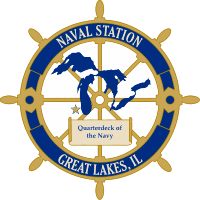
Naval Station Great Lakes insignia
|
|
|
Location in Illinois##Location in United States
|
|
| Coordinates | 42°18′36″N 87°51′00″W / 42.31000°N 87.85000°W |
| Site information | |
| Owner | |
| Controlled by | |
| Site history | |
| In use | 1911–present |
| Garrison information | |
| Past commanders |
Captain William Bulis, USN |
| Garrison | Recruit Training Command |
|
Great Lakes Naval Training Station
|
|
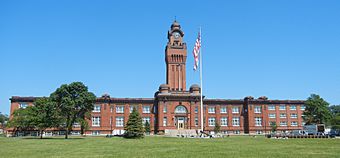
Great Lakes Building 1
|
|
| Nearest city | North Chicago, Illinois, U.S. |
| Area | 193.2 acres (78.2 ha) |
| Built | 1906 |
| Architect | Jarvis Hunt, Et al. |
| Architectural style | Classical Revival, Federal Revival |
| NRHP reference No. | 86002890 |
| Added to NRHP | September 15, 1986 |
Naval Station Great Lakes (often called NAVSTA Great Lakes) is a very important place for the United States Navy. It is the only place where new Navy recruits go through their basic training, also known as "boot camp." This large base is located near North Chicago, in Lake County, Illinois, right by Lake Michigan.
NAVSTA Great Lakes is the biggest military base in Illinois. It is also the largest training station in the entire Navy. The base has over 1,100 buildings and covers about 1,600 acres (6.5 square kilometers). It has 69 miles (111 kilometers) of roads to help people get around. Sailors sometimes call it "The Quarterdeck of the Navy." It's also known as "second boot camp" for those who attend Training Support Command.
The first 39 buildings were built between 1905 and 1911. They were designed by an architect named Jarvis Hunt. The base works like a small city. It has its own fire department, police (called Naval Security Forces), and a public works department. One famous building is Building 1, also known as the clocktower building. It was finished in 1911 and is made of red brick. It has a tall tower and faces a large parade ground called Ross Field.
Contents
Key Training Centers at Great Lakes
What is the Recruit Training Command?
The Recruit Training Command (RTC) at Great Lakes is where all new Navy recruits go for their basic training. Since 1996, it has been the Navy's only boot camp. Before that, there were other training centers in California and Florida, but they closed. Now, all new sailors come to Great Lakes.
About 40,000 recruits train here every year. At any time, there might be around 7,000 recruits on the base. The RTC Great Lakes has been training sailors for over 100 years!
What is the Training Support Center?
The Training Support Center (TSC) Great Lakes is a top Navy training center for technical skills. About 16,000 sailors train here each year. TSC helps six different learning sites, which teach sailors many important skills.
Some of the main schools at Naval Station Great Lakes teach sailors how to be:
- Electrician's mate (EM)
- Electronics Technician (ET)
- Fire Controlman (FC)
- Gunner's mate (GM)
- Interior Communications Electrician (IC)
- Boatswain's mate (BM)
- Operations Specialist (OS)
- Hull Maintenance Technician (HT)
- Damage Controlman (DC)
- Engineman (EN)
- Gas Turbine System Technician (Electrical) (GSE)
- Gas Turbine System Technician (Mechanical) (GSM)
- Machinery Repairman (MR)
- Quartermaster (QM)
- Machinist's mate (MM)
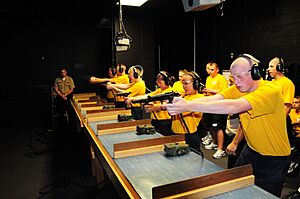
Some training courses, like for Culinary Specialists (cooks) and Hospital Corpsmen (medical staff), used to be at Great Lakes. However, they have moved to other locations to combine training with other military branches.
How Great Lakes Started
President Theodore Roosevelt approved the Great Lakes base in 1904. Navy Captain Albert R. Ross oversaw the construction. The first 39 buildings were designed by architect Jarvis Hunt. The base cost about $3.5 million to build. President William Howard Taft officially opened the Naval Training Station in 1911. The very first recruit, Joseph Gregg, arrived on July 3, 1911. He was part of the first class of 300 sailors.
During World War I, a famous band leader named John Philip Sousa led the Great Lakes Naval Station Band. From 1911 to 1916, about 2,000 recruits trained at Great Lakes each year.
Great Lakes During World War I
When the United States entered World War I in 1917, Great Lakes had about 1,500 sailors. By the end of the war, the base had grown a lot. It had 776 buildings and about 45,000 sailors in training. In total, 125,000 sailors trained at Great Lakes during the war.
Between the World Wars
After World War I, recruit training slowed down. The base even closed for maintenance from 1933 to 1935. It reopened after local business people and politicians worked to get it back. In 1936, aviation training moved from Great Lakes to another base.
Great Lakes During World War II
When Pearl Harbor was attacked in 1941, about 6,000 sailors were training at Great Lakes. This number quickly grew to 68,000 in six months. By September 1942, over 100,000 sailors were training there. The base grew to 1,600 acres (6.5 square kilometers).
The Navy chose Great Lakes to be the first place to train African Americans. In 1942, special training facilities were opened for them. At first, training was separate, but by mid-1945, all training was integrated. The Golden Thirteen, a group of African American officers, were commissioned in 1944 after training at Great Lakes. Over one million sailors trained at Great Lakes during World War II.
From 1946 to 1960
In 1948, a boot camp for female recruits, called WAVES, opened at Great Lakes. However, female recruit training moved to another base in 1951.
In 1954, new buildings for training Gunner's Mates and other technical roles were opened. One building, the Gunnery School, was very modern for its time. It was made mostly of glass. This building was taken down in 2012 because hands-on training changed to computer-based training. New barracks and classrooms were also built in the late 1950s.
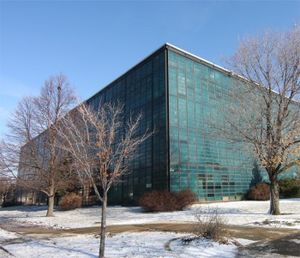
Great Lakes in the 1960s and 1970s
A new Naval Hospital opened at Great Lakes in 1960. During the Vietnam War, this hospital cared for many patients. The hospital building was taken down in 2013 after its services moved to a new health care center.
In 1965, parts of Great Lakes were used as a place to help after a plane crash. In 1967, a fire at Great Lakes sadly killed Rear Admiral Howard A. Yeager and two hospital corpsmen. In 1972, a tornado hit the base, injuring 18 people.
Changes to the Base
In 1993, a special commission decided to close recruit training in San Diego and Orlando. This made Great Lakes the only place for Navy recruit training. This change brought many new military and civilian jobs to Great Lakes.
In 2005, another commission suggested some changes that would mean fewer jobs at Great Lakes. However, the main recruit training and boot camp parts of the base were not closed. Almost $800 million was spent on building new barracks, training facilities, and other upgrades. Today, Naval Station Great Lakes remains the only boot camp for the United States Navy.
Sports at Great Lakes
The Great Lakes Bluejackets had football teams from the 1910s to the 1940s. They even won the 1919 Rose Bowl and beat the undefeated Notre Dame team in 1943. Famous football players like George Halas and Johnny Lujack played for Great Lakes. Well-known coaches like Paul Brown also coached here.
Great Lakes baseball teams were very successful during World War II. They won 188 games and lost only 32. In 1945, famous pitcher Bob Feller played a game for Great Lakes and shut out the Chicago Cubs.
Awards for the Base
Naval Station Great Lakes has received awards for its excellent facilities. In 2023, the base won the Admiral Elmo R. Zumwalt Award for Excellence in Housing and Lodging Management. This award recognized the great work of the Navy Exchange (NEX) store in making life better for people on the base.
The National Museum of the American Sailor is located at Great Lakes. It is one of the museums run by the Naval History & Heritage Command. This museum's job is to collect and share the history of the United States Navy, especially focusing on the stories of enlisted sailors.




